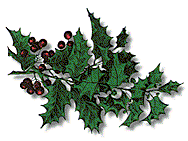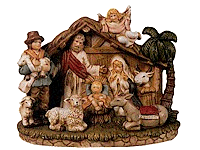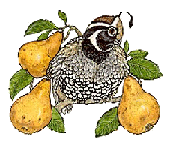Merry Christmas
Christmas is celebrated around the world in many different ways. The
difference in the traditions and cultures of the countries gave birth to the
variant styles of celebration. Nonetheless, the real spirit of Christmas
remains the same in most parts of the world. Here are a few examples of how
people wish Merry Christmas in different parts of the world.
|
United States
|
: Merry Christmas
|
|
England
|
: Happy Christmas
|
|
Ireland
|
: Nodlig mhaith chugna
|
|
German
|
: Frohliche Weihnachten
|
|
France
|
: Joyeux Noel
|
|
Spain
|
: Felices Pascuas, Feliz Navidad
|
|
Switzerland
|
: Veselé Vánoce
|
|
Italy
|
: Buon Natale.
|
|
Finland
|
: Hauskaa Joulua
|
|
Russia
|
: Pozdrevlyayu s prazdnikom Rozhdestva is Novim Godom
|
 The Date of Christmas
The Date of Christmas
The idea to celebrate Christmas on December 25 originated in the 4th century.
The Catholic Church wanted to eclipse the festivities of a rival pagan religion
that threatened Christianity's existence. The Romans celebrated the birthday of
their sun god, Mithras during this time of year. Although it was not popular,
or even proper, to celebrate people's birthdays in those times, church leaders
decided that in order to compete with the pagan celebration they would
themselves order a festival in celebration of the birth of Jesus Christ.
Although the actual season of Jesus' birth is thought to be in the spring, the
date of December 25 was chosen as the official birthday celebration as Christ's
Mass so that it would compete head on with the rival pagan celebration.
Christmas was slow to catch on in America. The early colonists considered it a
pagan ritual. The celebration of Christmas was even banned by law in
Massachusetts in colonial days.
Click here to view a list of dates for other winter festivals and celebrations.
 Mistletoe
Mistletoe
Two hundred years before the birth of Christ, the Druids used mistletoe to
celebrate the coming of winter. They would gather this evergreen plant that is
parasitic upon other trees and used it to decorate their homes. They believed
the plant had special healing powers for everything from female infertility to
poison ingestion. Scandinavians also thought of mistletoe as a plant of peace
and harmony. They associated mistletoe with their goddess of love, Frigga. The
custom of kissing under the mistletoe probably derived from this belief. The
early church banned the use of mistletoe in Christmas celebrations because of
its pagan origins. Instead, church fathers suggested the use of holly as an
appropriate substitute for Christmas greenery.
 Holly
Holly
The use of Holly as a symbolic winter decoration, with its shiny, prickly
leaves and blood-red berries, goes back in history to the Celtic peoples of
Northern Europe, who decorated their homes with it during the time of the
winter solstice, or Yule. The ancient Romans believed that holly warded off
lightning strikes and witchcraft and sent boughs of holly to friends during the
festival of Saturnalia, also celebrated at the winter solstice. The early
Christian Church retained many of the Celtic and Roman traditions to help
celebrate the birth of Christ. The early Celtic Christians associated the
prickly holly leaves with the crown of thorns from the crucifixion and the red
berries with the blood of Christ.
Londoner's decked their shops, homes, and churches with holly in Charles
Dickens' time. While the German's were decorating tall green fir trees with
colored paper, fruits and sweets, Victorian England hung bows of holly, ivy,
and mistletoe on their walls and mantles. Victorian merchant, Henry Mayhew
estimated London merchants sold 250,000 bushels of holly during the Christmas
season in 1851.
In parts of England and Germany, tradition held that the man ruled the home if
prickly or "he" holly was brought home at Christmas. Smooth leafed "she" holly
ensured the woman's rule.
Holly was also a popular Christmas decoration in Massachusetts in the late
1800's and early 1900's when extensive stands of native wild holly grew in New
England. Over harvesting for Christmas decorations, ploughs and bulldozers had
seriously reduced the holly supply and habitat by 1925 when Wilfred Wheeler
established a holly plantation on Cape Cod in an attempt to protect the last
remaining wild holly in Massachusetts.
The Audobon society now manages Wheeler's plantation in the Ashumet Holly
Reservation, which is open to the public. For the tallest holly you'll have to
travel to Louisiana where warm, moist growing seasons have produced 100 foot
trees.
Click here to read The Legend of The Holly.
Click here to read The Story of Mary and The Little Holly Bush.
 Poinsettias
Poinsettias
Poinsettias are native to Mexico. They were named after America's first
ambassador to Mexico, Joel Poinsett. He brought the plants to America in 1828.
The Mexicans in the eighteenth century thought the plants were symbolic of the
Star of Bethlehem. Thus the Poinsettia became associated with the Christmas
season. The actual flower of the poinsettia is small and yellow. But
surrounding the flower are large, bright red leaves, often mistaken for petals.
Click here to read The Legend of The Poinsettia.
 The Candy Cane
The Candy Cane
In the late 1800's a candy maker in Indiana wanted to express the meaning of
Christmas through a symbol made of candy. He came up with the idea of bending
one of his white candy sticks into the shape of a Candy Cane. He incorporated
several symbols of Christ's love and sacrifice through the Candy Cane. First,
he used a plain white peppermint stick. The color white symbolizes the purity
and sinless nature of Jesus. Next, he added three small stripes to symbolize
the pain inflicted upon Jesus before His death on the cross. There are three of
them to represent the Holy Trinity. He added a bold stripe to represent the
blood Jesus shed for mankind. When looked at with the crook on top, it looks
like a shepherd's staff because Jesus is the shepherd of man. If you turn it
upside down, it becomes the letter J symbolizing the first letter in Jesus'
name. The candy maker made these candy canes for Christmas, so everyone would
remember what Christmas is all about.
 Xmas
Xmas
This abbreviation for Christmas is of Greek origin. The word for Christ in
Greek is Xristos. During the 16th century, Europeans began using the first
initial of Christ's name, "X" in place of the word Christ in Christmas as a
shorthand form of the word. Although the early Christians understood that X
stood for Christ's name, later Christians who did not understand the Greek
language mistook "Xmas" as a sign of disrespect.
 The Legend of the Robin
The Legend of the Robin
On the night that Baby Jesus was born, a plain brown bird was watching from her
nest in the loft of the stable. During the night, a cold breeze came through
the drafty stable, and Mary was afraid the Baby would not stay warm. Joseph
built a small fire, but it was not enough. The bird was watching from her nest
and knew that this Child was very special. She flew down to the fire and gently
flapped her wings to fan the fire. She was very close to the fire and became so
hot that her feathers turned red. But she stayed by the fire all night to keep
the Baby warm. The breast of the robin has been red since that night to remind
us of the love and dedication she showed.
 Christmas Wreaths
Christmas Wreaths
House decorations like holly and mistletoe are also an important part of
Christmas. Holly was once a pagan symbol used to ward off evil spirits.
Legend says that the crown of thorns Christ wore at his crucifixion had holly
in it, but the berries were white. As Christ's blood touched the white
berries, they turned red. From that moment on, holly berries have been red.
The same legend is also believed to have originated the Christmas Wreath, since
wreaths are round like a crown and usually have holly woven through them too.
 The Nativity
The Nativity
The nativity scene probably has the most religious value in the modern
Christmas. Saint Francis of Assisi, wanted to show the humanity and humility of
Jesus, so he created a reenactment of Christ's birth. The church was a very
rigid institution, insisting that life was a place of sorrow and sin. St.
Francis created the nativity scene to send a positive message of hope and
God's love. The first nativity scene used real animals and people. A church
choir stood around the scene singing the scriptures, the first known act of
caroling.
 The Twelve Days Of
Christmas
The Twelve Days Of
Christmas
From 1558 to 1829, the
Catholics in England were forbidden to practice their Faith openly. During
this period, "The Twelve Days of Christmas" was written in England as a
catechism song for young Catholics. The hidden meanings of the song's gifts
were intended to help the children learn their Faith. The "true love"
mentioned in the song refers to God Himself while the "me" who receives the
presents is symbolic of every baptized person. The meanings of the symbols are
as follows:
-
A partridge in a pear tree:
Jesus Christ
-
Two turtle doves:
The Old and The New Testament
-
Three French hens:
Faith, Hope and Charity
-
Four calling birds:
The Four Gospels
-
Five golden rings:
The Pentateuch
-
Six geese a-laying:
The six days of creation
-
Seven swans a-swimming:
The seven gifts of the Holy Spirit
-
Eight maids a-milking:
The eight Beatitudes
-
Nine ladies dancing:
The Nine Fruits of the Holy Spirit
-
Ten lords a-leaping:
The Ten Commandments
-
Eleven pipers piping:
The eleven faithful disciples
-
Twelve drummers drumming:
The twelve points of belief in the Apostles Creed
 Lighting the Christmas Tree
Lighting the Christmas Tree
Using small candles to light up the Christmas tree dates back to the middle of
the 17th century. The custom was only really firmly established, however, at
the beginning of the 19th century in Germany and soon after in the Slavic
countries of Eastern Europe. The first candles were glued with wax or pinned
to the end of the tree branches. Little lanterns and small candleholders then
appeared to make putting up the tapers easier. Candleholders with clips
appeared around 1890. Glass balls and lanterns were created between 1902 and
1914.
The first time a Christmas tree was lit by electricity was in 1882 in New York.
Edward Johnson, a colleague of Thomas Edison, lit a Christmas tree with a
string of 80 small electric light bulbs which he had made himself. These
strings of light began to be produced around 1890. One of the first
electrically lit municipal Christmas trees was erected in Westmount, Quebec in
1896. In 1900, some large stores put up large illuminated trees to attract
customers.
Once begun, the custom spread wherever electricity was available. Because of
the risk of fire, trees were not usually put up until December 24. However,
this technical innovation altered the custom since it was now possible to put
the tree up earlier and leave it up longer, until the day before Epiphany.